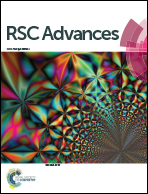Substituent effect on the radical scavenging activity of 6-chromanol derivatives†
Abstract
Several 6-chromanol derivatives with various substituents (one or two amino, acetylamino, chloro or nitro substituents at the 5-, 7-, 8- or 5,7-positions on the phenyl ring of 2,2-dimethyl-6-chromanol) were synthesized, and their second order rate constants (k) for a reaction that demonstrates radical scavenging activity (reaction with the galvinoxyl radical) were determined. Three monoacetylamino compounds, 8-nitro compound, and 5,7-diamino, 5,7-diacetylamino, and 5,7-dinitro compounds were newly synthesized. log k was plotted against the Hammett sigma (σm) or Taft sigma (σ*) constants for the compounds containing each of the four substituents to obtain their reaction constants (ρ) from the slopes. The σ plots representing radical scavenging activity showed a linear correlation with negative ρ values for all compounds with substituted positions. The results indicate that the electron-donating effect of the amino and acetylamino groups on the chroman ring enhanced radical scavenging activity, whereas the electron-withdrawing effect of the chloro and nitro groups decreased this activity. Furthermore, the magnitude of ρ for the substituted compounds increased in the following order with respect to the substitution position: meta-substituted (−3.71 for 6a–d), ortho-monosubstituted (−0.86 for 4a–d, −0.87 for 5a–d), and ortho-disubstituted (−0.47 for 7a–d). The greater ρ magnitudes for the meta-substituted compound indicated that the radical scavenging reactions were more sensitive to inductive substituent effects than for the ortho-substituent compounds. The ρ values for ortho-mono- and ortho-disubstituted compounds were smaller than that for the meta-substituted compound, despite the fact that the k values for the ortho-substituted compounds were higher than those for the meta-substituted compounds. Thus, electron-donating groups in ortho-substituted 6-chromanols accelerate the reaction rate through resonance stabilization in addition to the inductive substituent effect.


 Please wait while we load your content...
Please wait while we load your content...